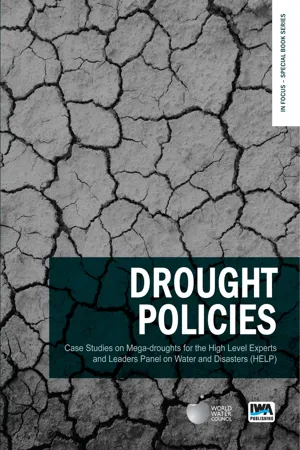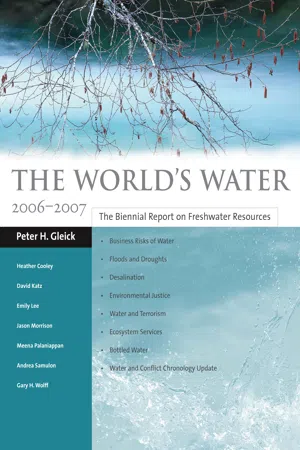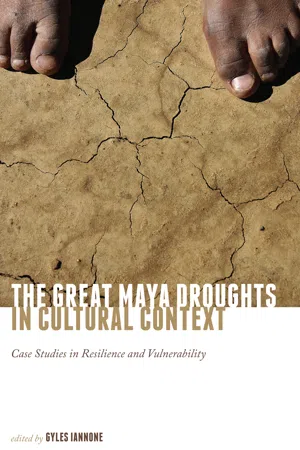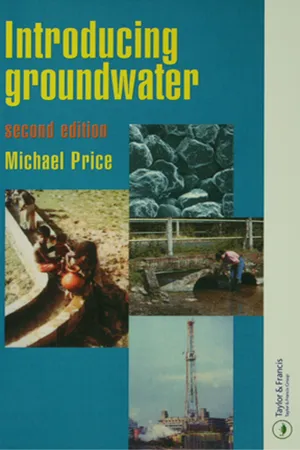Drought
Drought is a prolonged period of abnormally low rainfall, leading to water shortages and environmental stress. It can have significant impacts on agriculture, water supplies, and ecosystems, often resulting in food and water scarcity, economic losses, and social disruption. Droughts can be caused by natural climate variability, such as El Niño events, as well as human activities like overuse of water resources.
6 Key excerpts on "Drought"
- eBook - ePub
Drought Policies
Case Studies on Mega-droughts for the High Level Experts and Leaders Panel on Water and Disasters (HELP)
- Jerome Delli Priscoli, Kenzo Hiroki, Jerome Priscoli, Kenzo Hiroki(Authors)
- 2019(Publication Date)
- IWA Publishing(Publisher)
...There are also sub-types of hydrological Droughts, such as soil moisture Drought and groundwater Drought. Agricultural Drought relates to a specific kind of crop, depending on various factors including the type of crop and its ability to store water, the stage of the growth cycle, soil type, temperature, etc. It describes the water stress on a crop determined by water supply and evapotranspiration, which may arise from both unexpected lack of rainfall or bad planning of the water demand during the growth cycle, e.g. by planting the crop too early or too late. Agricultural Drought may lead to poor yield, but also to total crop loss. Socioeconomic Drought links human activity with the above Drought definitions, which are described by purely physical/biological characteristics. In very general terms, it may be described as a failure of the water supply to meet the water demand of a – local, communal, regional or national – society. Both sides may contribute to this type of Drought: the supply side through lack of rainfall, and the demand side through overuse of existing resources. This is the type we are talking about in the context of Drought disasters. Further characterizations of Droughts refer to duration, geographical extent and severity. While seasonal Droughts usually cause only material losses and temporary, but potentially severe, inconvenience, multi-year Droughts (‘megaDroughts’) have led to mass migrations of people throughout history and an irreversible loss of species. The larger Drought-affected regions become, the more difficult it is to assist them with external supplies, in particular in areas with poor transport infrastructure. Recurrent Droughts in a region may lead to desertification, i.e. the degradation of land that transforms originally productive land into wasteland. Drought severity is commonly described by way of indices, which are mostly based on meteorological parameters...
- eBook - ePub
Exploring Environmental Issues
An Integrated Approach
- David D. Kemp(Author)
- 2004(Publication Date)
- Routledge(Publisher)
...The establishment of political boundaries, which took no account of environmental patterns, also restricted migration in certain areas. As a result, in those areas susceptible to Drought, the tendency, perhaps even the necessity, to challenge the environment grew. If sufficient water was not available from precipitation, either it had to be supplied in other ways — by well or aqueduct, for example (see Chapter 8) — or different farming techniques had to be adopted to reduce the moisture need in the first place. The success of these approaches depended very much on such elements as the nature, intensity and duration of the Drought, as well as on various human factors, which included the numbers, stage of cultural development and the technological level of the peoples involved. Thus a number of human ingredients have been added to the physical components of Drought, and these have been responsible for exacerbating problems of water availability, not just in areas experiencing Drought, but in adjacent areas as well. PERCEPTIONS, IMAGES AND IMPACTS OF Drought Drought can be defined or measured in a number of ways. To some it is a long dry spell during which lawns turn brown and crops shrivel and die. To others it is a complex combination of meteorological elements, expressed in some form of moisture index, or a moisture deficiency measured against normal or average conditions, established through long-term observation (Katz and Glantz 1977). Drought is very much a human concept, and many current approaches to the study of Drought focus on its impact on human activities (see e.g. Mortimore 1989; Glantz 1994). Agriculture is particularly susceptible to moisture deficiency and the retardation of crop growth or development is commonly one of the first effects of Drought...
- eBook - ePub
The World's Water 2006-2007
The Biennial Report on Freshwater Resources
- Peter H. Gleick, Gary H. Wolff, Heather Cooley, Meena Palaniappan, Andrea Samulon, Emily Lee, Jason Morrison, David Katz(Authors)
- 2013(Publication Date)
- Island Press(Publisher)
...For example, a three-month dry period during the growing season in the Midwest of the United States would adversely affect agriculture but would have little impact on most fish and wildlife populations. On the other hand, a dry period of that duration during the growing season in California is normal and would not constitute a Drought. A complex irrigation system in California allows farming during hot, dry summers, whereas farmers in the Midwest largely rely on rain to irrigate their crops. A Drought is a temporary phenomenon and, as such, it is distinct from aridity, which is a climatic feature of a particular region. Although perceived as rare, Droughts occur periodically in every climatic zone. Some areas, however, are clearly more Drought-prone than others. Kenya, for example, experiences a major Drought every decade and minor Droughts every three to four years (UNEP and the Government of Kenya 2000). London, on the other hand, experiences Drought much less frequently (although, ironically, as this volume was being prepared, London was experiencing one of its worst Droughts in decades). Determining the beginning of a Drought is difficult, and it is often better defined in hindsight; what begins as an extended spell of good weather can become devastating, destroying crops and spawning vast wildfires. Scientists typically evaluate Droughts based on precipitation, temperature, and soil-moisture data. The data are often encapsulated by a Drought index. However, a dizzying array of indices is available, each possessing particular strengths or weaknesses. The Palmer Drought Severity Index, for example, is based on a soil-moisture algorithm and is best suited for homogenous landscapes. This index is not appropriate for regions with lags between precipitation and runoff, such as California and Colorado (Hayes n.d.). The Standard Precipitation Index is based on the long-term precipitation record for a specific location...
- eBook - ePub
- Rattan Lal(Author)
- 2017(Publication Date)
- CRC Press(Publisher)
...Drought: Precipitation, Evapotranspiration, and Soil Moisture Joshua B. Fisher Konstantinos M. Andreadis Jet Propulsion Laboratory, California Institute of Technology, Pasadena, California, U.S.A. Abstract Drought is major hydrological disaster for human society and encompasses multiple hydrological components. There are numerous definitions of Drought, many of which do not include transpiration or evaporation [evapotranspiration (ET)]. In this entry, we describe the role of ET in Drought, and why ET is important to consider when assessing Drought. We emphasize the dynamic roles of ET, precipitation, and soil moisture, with a focus on vegetation response during water stress. Finally, we conclude with a case study example of Drought in Amazonia. INTRODUCTION Drought ranks as one of the most expensive natural disasters in terms of human welfare and food security. For example, in the United States, the annual cost of Drought relief measures has been estimated between US$6 billion and US$8 billion. Droughts can cover very large areas and last for several years with the so-called megaDroughts documented from medieval times. [ 1 ] In general terms, Drought is caused by extremes within the natural variability of climate but can be exacerbated by human activity (e.g., deforestation). The literature on Drought is extensive, with definitions categorically ranging from meteorological (climatological, or atmospheric), agricultural, hydrologic, and socioeconomic (e.g., management based), [ 2, 3, 4, 5 ] but we focus here on the vegetation transpiration and evaporation [actual evapotranspiration (ET)] component of Drought. [ 6 ] From a vegetation perspective in general, physical Drought is the drying of soil such that the overlying vegetation experiences physiological water stress manifested in a reduction of productivity, loss of leaves/needles, and, ultimately, mortality...
- eBook - ePub
The Great Maya Droughts in Cultural Context
Case Studies in Resilience and Vulnerability
- Gyles Iannone(Author)
- 2014(Publication Date)
- University Press of Colorado(Publisher)
...This transformation of the bajos represents one of the most significant and long-lasting anthropogenic environmental changes documented in the pre-Columbian New World (Dunning et al. 2002). Pollen records indicate that at the time of the Terminal Classic collapse (ca. AD 750–1050) many watersheds exhibited largely deforested landscapes (see Leyden 2002), and Adams (1996) speculates that by AD 750 “nearly every square meter of land had been modified.” Although this estimate may perhaps be a bit extreme, it gives a general impression of the scale of deforestation that may have been occurring. Droughts It is important to specify what we mean by Drought in this chapter. There are, of course, a wide range of definitions for what constitutes a Drought (see Me-Bar and Valdez 2003 ; Wilhite and Glantz 1985) and how it is experienced on the ground (see this volume, Iannone, Yaeger, and Hodell [Chapter 3]; Valdez and Scarborough [Chapter 12]). As discussed below, we limit our study here to the linkage between human land use (deforestation), local atmospheric patterns (rainfall and temperature), and agricultural production. How we use the term Drought is intrinsically tied to both yields on an individual agricultural field and to the functioning of the agricultural system as a whole. The term Drought in this chapter can therefore be imagined as moderate to severe Droughts as defined by Valdez and Scarborough (Chapter 12 in this volume) or meteorological, hydrological, and agricultural as defined by Wilhite and Glantz (1985 ; see also Iannone, Yaeger, and Hodell, Chapter 3 in this volume). Naturally occurring Droughts were prevalent during the period of Maya occupation of the Yucatan Peninsula and remain so today. Many of these were multiyear Droughts: periods that exhibited less than average yearly rainfall totals...
- eBook - ePub
- Michael Price(Author)
- 2013(Publication Date)
- Routledge(Publisher)
...What we can say is that the changes we can see happening in the Earth's climate are in line with the predictions of global warming based on the EGE; they do not necessarily confirm those predictions. Notwithstanding the recent problems, the general trend is for the British climate to get wetter. There is also a general tendency for rainfall to increase in winter and decrease in summer. These statistical trends are also in line with the predictions of global warming, and from the water-resources viewpoint look a good thing. But they do mean that the country will be increasingly vulnerable to the rogue years that defy the statistics, and leave us with an exceptionally dry winter in between the drier summers. Perennial Drought — Deserts There are some areas of the world where Drought is not an unusual occurrence, as it is in Western Europe, but is the normal state of affairs; these areas are the deserts. As in the case of Droughts, there is no generally accepted definition of a desert. Regions with low precipitation (less than 250 mm per year) can be found at most latitudes, but the areas that most people would regard as deserts have low precipitation and lie between latitudes 15° and 50° north and south of the Equator. These areas are characterized by their dryness, lack of vegetation and sparse population. Some are sandy, with or without dunes; some are covered with gravel, and others are predominantly bare rock. Surface drainage in true deserts is virtually non-existent, being present only after heavy rainstorms which may occur less than once in a hundred years; in semi-deserts, such as some of the intermontane regions of the United States, rainfall is more frequent and gives rise to ephemeral streams. Semi-arid areas occur in North Africa, on the edge of the Sahara, and here these ephemeral watercourses are termed wadis...





